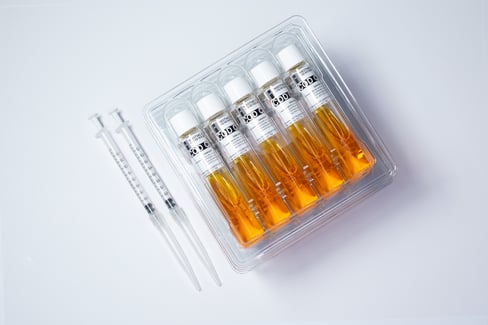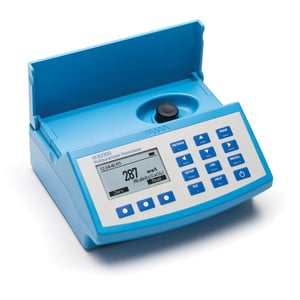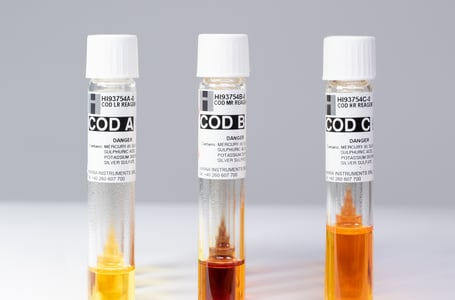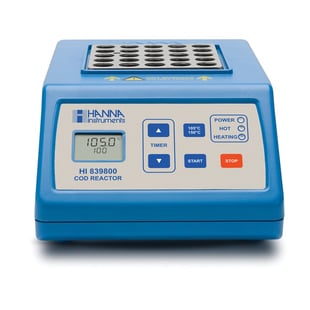
What is Chemical Oxygen Demand?
Chemical oxygen demand (COD) is an indirect measurement of the amount of organic matter in a sample. When performing a COD test, you can measure virtually all organic compounds that can be digested by a digestion reagent. Performing this test the correct way is important in determining wastewater treatment effectiveness and can help diagnose any problems in treatment.
COD contrasts with biochemical oxygen demand (BOD), which relies on the use of microorganisms to break down the organic material in the sample by aerobic respiration over an incubation period (typically five days).
BOD and COD correlate with one another in virtually all samples, but BOD is always lower than COD as the biochemical breakdown of organics is often not as complete as the chemical method.
Importance of Chemical Oxygen Demand
BOD and COD are critical in wastewater for determining the amount of waste in the water. Waste that's high in organic matter requires treatment to reduce the amount of organic waste before discharging into receiving waters.
If water treatment facilities do not reduce organic content of wastewater before it reaches natural waters, microbes in the receiving water will consume the organic matter as well as the oxygen. This oxygen depletion along with nutrient rich conditions is called eutrophication, a condition of natural water that can lead to a mass death of animal life.
Wastewater facilities reduce COD and BOD by using these same microbes under controlled conditions. These facilities aerate chambers injected with specialized bacteria that can break down the organic matter in an environment that does not harm natural waters. A reduction in BOD is used in these facilities as a benchmark for treatment effectiveness.
Since a BOD test takes five days to complete, COD is used to monitor the treatment process in day-to-day operations. The COD test takes only a few hours to complete. If BOD was always used, a problem with the treatment process wouldn’t be detected until five days later. This would mean that wastewater would need to be held for days until results could be verified.
Hanna Tip: Due to the speed of testing, facilities usually establish a correlation between BOD and COD, then only run BOD occasionally. However, be sure to check with your local regulatory agency for detailed advice on BOD and COD testing regimens.

How to Measure Chemical Oxygen Demand
As mentioned before, COD measures organic matter by using a chemical oxidant. It’s critical that a strong enough oxidant is used to react with virtually all organic material in the sample. Historically, potassium permanganate filled this role, but it was found to be inconsistent in its ability to oxidize all the organic matter in a wide variety of waste samples.
Currently, most COD tests use potassium dichromate as the oxidant. Potassium dichromate is a hexavalent chromium salt that is bright orange in color and is very strong. Between 95-100% of all organic material can be oxidized by dichromate. Once dichromate oxidizes a substance it's converted to a trivalent form of chromium, which is a dull green color.
Digestion is performed on the samples with a set amount of the oxidant, sulfuric acid, and heat (150°C). Metal salts are usually included to suppress any interferences and to catalyze the digestion. This digestion typically takes two hours to perform.
During the digestion, it's necessary to have excess oxidant as this ensures complete oxidation of the sample. As a result, it’s important to determine the quantity of excess oxidant. The two most common methods for this are titration and colorimetry.
Titrimetric Method of COD
In the titration method for determining COD, the excess dichromate is reacted with a reducing agent, ferrous ammonium sulfate. As the ferrous ammonium sulfate (FAS) is added slowly, the excess dichromate is converted into its trivalent form.

As soon as all the excess dichromate reacts, an equivalence point is reached. This point means that the amount of ferrous ammonium sulfate you added is equal to the amount of excess dichromate. Color indicators can also signal this endpoint, but the process may be automated with a potentiometric indicator (like an electrode).
Afterwards, you can calculate how much dichromate went towards oxidizing organic material based on how much we initially added and how much was left over.
Colorimetric Method of COD
You can quantify the amount of trivalent chromium in a sample after digestion by measuring the absorbance of the sample at a wavelength of 600 nm in a photometer or spectrophotometer. Alternatively, the absorbance of hexavalent chromium at 420 nm can be used to determine the amount of excess chromium at the end of digestion to determine COD values.

This method is easy and requires just a few simple steps.
- Digest your samples and a reagent blank. (The reagent blank is just a sample of deionized water that’s treated the same as your actual samples. You can even reuse the blank for as long as your reagent batch lasts.)
- Let the digested samples and blank cool.
- Zero the instrument using the blank vial.
- Read the samples.
Which method is best for me?
While both methods are EPA-approved, they have their own advantages and disadvantages.
Titration is less equipment-intensive since the only equipment you need is a burette, heating block, and digestion vials. However, the procedure is a little more labor-intensive. An automatic titrator can reduce the amount of user input required and can be used for other applications in wastewater (e.g. alkalinity, volatile acidity).
Although colorimetry requires a spectrophotometer or photometer, it offers convenience since most manufacturers offer premixed reagents, so all you need to do is run your samples with the digestion chemicals and minimal contact.
Colorimetry also makes measurement easy since all the analyst needs to do is digest the samples and let the instrument do the work. For these reasons, colorimetry is the most common method to measure COD.
"So what do I need to start testing?"
1. Heating block
Both methods for COD testing require the digestion step, so a heating block for your samples is crucial for ensuring accurate and repeatable results. For best results, look for a heating block that features multiple temperatures, so you have utility for other tests, such as total phosphorus. Most heating blocks also have timers, which are critical for keeping digestion times consistent over multiple runs.
For added safety, look for models that have an optional shield that covers the heating block in case of an accident.
2. Colorimeter or spectrophotometer
The colorimeter or spectrophotometer is the device that is going to read the absorbance of the samples after digestion in order to correlate it to the COD concentration. Colorimeters use filters to measure light as specific wavelengths, but spectrophotometers use a device that allows measurement across a wide spectrum. Regardless of which instrument you choose, look for models that feature preprogrammed methods for COD for ease-of-use.
3. Reagents

Reagents are one of the most important components of the COD testing system. These chemicals are responsible for oxidizing the organic material. There are several types of reagents available commercially:
- EPA-compliant reagents: These vials comply with EPA method 410.4 and Standard Methods 5220D. These reagents use the formulation for this method, which contains mercury sulfate, potassium dichromate, and sulfuric acid. Choose these vials if your work requires you to report COD results to a regulatory agency requiring EPA methodologies.
- ISO-compliant reagents: Conform to ISO 15705:2002 methods with respect to their composition. These compositions of these COD vials are similar to that of EPA standards, so they also contain mercury.
- Mercury-free reagents: Most COD vials contain mercury sulfate to remove chloride interferences, which would otherwise create a falsely high COD value. COD-free vials do not contain mercury, which makes them more susceptible to chloride interferences, but greatly reduce the safety and environmental risks of handling mercury. As a result, these reagents are ideal for routine analysis where no or very low chloride concentrations are expected.
That's why we've dedicated our blog as a helpful resource for you to use! Catch up on the latest products, explore industry trends, discover testing tips, learn how to improve results, and more. Got questions? Email sales@hannainst.com.


